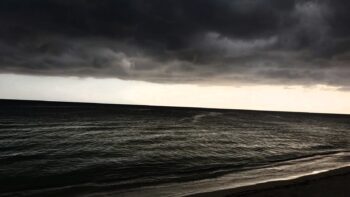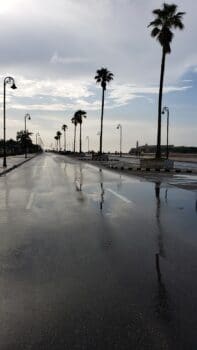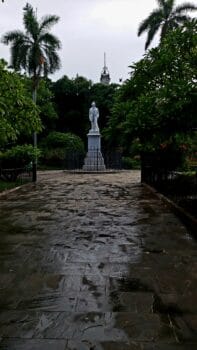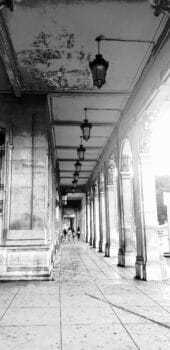Nelson Leiva holds a Bachelors Degree in Political Science from CSULA. He is an enthusiastic non professional photographer who adds to his routine the visual and social enriching experience that accompanies architectural photography.
Nelson Leiva’s images are transitional.1 They can be interpreted as standard and tourist. Yet they share a ballad of serenity as a sobering encounter when he emerges into an unfamiliar scene. This new scene would be an awakening and cathartic moment upon his arrival to Cuba (8/19).
His photography reflects the preservation of Cuba’s architectural environment in a liberating space. Leiva’s personal journey in this series brings to conversation the role of modernity’s perpetual belief of regeneration (rebirth) through progress. In were by capitalist pretentious innovative use of space in an architectural/structural forms (setting), imply the implementation and continuation of destructive spiritless/profit geared ideologies. It’s a western civilizing hegemonic binary doctrine of development (in order to build you must destroy). This is the initial stage of colonization; the subjugation (sacrilege) of indigenous/aborigine space, memory, cosmovision, culture, destroying pre-colonial architecture and the subjecting of the natural environment where by Cartesian Eurocentric though; fractures pre-colonial beliefs of unity (wholeness) between body and earth /pachamana (subject to subject). This colonial imposition is the understanding of mind over nature (subject object relations). The same stone that once participated in the making of temples of mediation, celebration and rituals (prior to 1492) would be used to build architectural colonizing spaces. Hence the birth of the modern state as it is known today is fabricated within the context of us vs. otherness. When addressing modernity philosopher Juan Jose Baustista S. describes modernity as “almost nihilist in negating all that is not European or modern.” Yet he cautions us to avoid a nihilist view of modernity.2
Leiva’s images bring forward modalities of interpreting environment and urban landscapes defined by Cuba’s preservation of landmarks that are crucial to the memory of resistance, justice, rebellion, de-colonial struggles and harmony. For scholar Ngũgĩ wa Thiong’o a “colonial act, any act in the context of conquest and domination is both a practice of power, intended to pacify a populace and a symbolic act, a performance of power intended to produce docile minds.”3 To an extent Ngũgĩ wa Thiong’o emphasis on memory can be interpreted as: the production of docile minds to transfer and impose westernized values and ways of reasoning. The citizen becomes the depository by which values; norms, language, reasoning and Eurocentric logic dictate outcomes favorable to capitalism/modernity.4
What shapes Cuba’s landscape is sculpt by living with it as a de-colonial framework of co-existence and co-responsibility. Unlike capitalist societies, were aesthetics is a cosmetic function to conceal the profit geared utility use of space and power. Such a perception leads to the objectification of space. Cuba, on the other hand with minimal access to resources prioritizes the function of memory as a liberating collective imaginary at the service of life devoid of profit speculation. The perception as to how space/land is used can be said to parallel Emiliano Zapata’s manifesto, “la tierra es de quien la trabaja con las manos.” In other words land is Pueblo. Same came be said of Cuba.
Leiva’s scenic images maintain a nostalgic sentiment not with the past, but of interaction with un-satured ambiences of sublime religious like messages of consumerism and entertainment. Nostalgia in a sense brings the sentiment of not able to share ourselves with nature as one half of who we are. For Leiva, back home, there is no room for “nostalgia, It is phased out to a rhythm of city life compartmentalized in many invisible ways. “His grey monochrome beach scene with a clear ribbon of sunlight between a vast dark ocean and violet grey strata of clouds rumbles across an extended scene of majestic nothingness. It is a reminder that we are neighbors to the unknown. There is a sense of homage to horizons as springs of renewable revolutionary hope with every sunrise and with every sunset. It made Leiva “wants to walk on the ocean’s glass like surface.” His comment has a sacred ring (ceremonial) of appreciation to an unconstraint moment of emotion in the presence of nature as pre-culture beauty.
Leiva’s images of silent Alamedas and the ocean wet images with a sea salt aroma works its way out of the framed picture to become a symbolic reference to the fertilization of unexamined/unedited emotions and thoughts with his new bound submergence in Cuba’s idiosyncrasies, Caribbean geography, history, rhythm, time and culture. He reveals pensive images that speak with a clear silence of countless weathered words. For writer Roland Barthe considers pensive images to be subversive. The contact with the Caribbean would bring amongst the colonizers the following question, are the inhabitants of these lands humans? Do they possess a soul? These questions would lead to a rational accompanied by a logic that would eventually justify domination and the exploitation of the Caribbean Native people. This line of Eurocentric reasoning would extend throughout the Global South in the following five centuries of colonization to this very day.
Historically, for the most part with the emergence of colonization, space and place under a western gaze implies perceiving uninhabited space as empty zones, unclaimed territories devoid of life and ownership.5 Second, uninhabited spaces are interpreted as territories to be explored, conquered, controlled and claimed (case in point is the controversial Mayan train mega project launch by Mexico’s President AMLO contested by a multi coalition of indigenous communities).6 Such perception disregards all life that is not human. Third, human lives are second to the concept of private property. All of the above variables entail a utilitarian self serving way of conceiving space/land/life under a capitalism form (private property) and to an extent orthodox 20th century socialist value of ‘progress’ (extraction, ect). Ngũgĩ wa Thiong’o describes the colonizing experience, “When Europeans contemplated Africa through the prism of its bourgeois desire to conquer and dominate, it saw nothing but uninhabited lands.”7
For capitalism, it exclusively translates to generate greater capacity for a variety of sensations as a means of capital/profit extraction by the special interest class and everything else that befalls under the umbrella of capitalist relations (macro to micro). In the United States capitalist entities or corporations (consisting of non living material) have the same constitutional rights as individuals. It is inconceivable to cede nature (a living organism) any constitutional rights as a living subject similar to corporations or individuals. This Contradiction is addressed with laws and treaties to protect nature (or in Native American territories) which too often are revoked in the interest of capital and private interest under national security or eminent domain arguments.8
The role of light of Leiva’s images is not that of claro oscuro or sensational dramas of light in performance with its subject matter. Instead the natural light serves as a soft see through curtain that tones Leiva’s intake of a graceful welcome.
Neither is Cuba’s space etched with the signature of opulent reminders of wealth alongside dire poverty. Conquering homage’s as well as dominating structures of power (sky scrapper, statues), symbols, social hierarchies and homage to the rich and famous, do not suppress or occupy any space nor compress cultural liberating signifiers to senseless adornments and consumerist ideologies. The Cuban Revolution transforms it political and cultural landscape post 1959. What begins to birth is an attempt to build a historical subject on a different set of social relations that does not entail exploitation between human beings and human beings with their natural environment.
Leiva forwards a visual sensitive interpretation of the meaning of memory vs. forgetfulness and ‘place’ as an affirmation of identity in relation to the concept of Pueblo. In his image of national and continental hero monument dedicated to Jose Marti, the key like landscape opens up the space as a site of contact and interface. Marti’s philosophical enclave radiates multiple ways of being that intersect when he consider himself in the following way, “first I am a humanist, second a Cuban and third a Latin American.” All three concepts/identities; global, national and regional embrace Marti’s multi-dimensional unifying continental vision put forth in his masterful essay Nuestra America.9 For Marti felt “Our own Greece is preferable to the Greece that is not ours: we need it more.” If liberation is to dwell, it must be with the soul of the land and not against it. The Mayan Popol Vuh considered as the Mayan bible of creation synthesizes such human/Earth relationship as “He who makes an enemy of the Earth makes an enemy of his own body.”10
In metro poles like Los Angeles, in where structures serving as bench marks, local signifiers and points of references relevant to a community’s history, are in a constant risk of erasure. The consequential impact is the potential loss of mental mapping (synapses) that no longer triggers historical memories.
Hence, the overwhelming structures dedicated to the promotion of consumerism (the contesting of space between the state and a community of people) and the gentrified class conflict that arises in neighborhoods of color. With one recent exception of a recent installed sculpture The Bracero Monument dedicated on September 29th 2019 to the Mexican Jornaleros/ braceros of the 1940s and 1960s near the Mexican Placita Olvera historical site in Los Angeles, California. This commemorative statue of a campesino migrant family took years in the making by fundraising and the arduous lobbying with city officials. This achievement was made possible by persistent surviving farm workers known as Union Binacional de Ex-Braceros 1942 -1964 and family descendants of the braceros. Hence it is a construct of memory built to make evident a structure which entails to ‘bring into appearance’ a community historically neglected, un-acknowledged and discriminated against.
Despite difficult challenges, the Cuban pueblo has been spared such traumatic experiences of erasure. In Leiva’s images space becomes place. And place is contingent to how it engages (empowers) with people and/or how people engage with space. For place and space in Cuba are vocal convergences of human dignity. No representation of hate and power occupy, share or shape any given location in Cuba. It is not allowed to perform or radiate detrimental alliances between acts of racial superiority and memories of master/slave narratives. No room for Ca’ Rezzonico sculptures of chains around legs or neck of slaves. No Frank Rizzo (Philadelphia mayor 1972- 1980)11 ten foot bronze sculpture representing antihuman beliefs, or confederate like reminders stand in any of Cuba’s architectural environment.12 No slave trader statues like Edward Colston (recently remove in Bristol, England by BLM) erects in any perceivable square footing on Cuban soil.13 There are no structure semblances to colonizers Christopher Columbus or Theodore Roosevelt.14 Such colonial monuments and sculptures are conversations of we don’t belong together.
This set of photographs unconsciously set forth the discussion of how space/place shapes national identity/memory in the public sphere. The shaping of space and place is determined by ideology and priorities. In the case of Cuba a socialist country, space becomes a capitalist free zone environment. The recent undisclosed contradiction found in western modern societies sailing under the banner of democracy reflect the continuing support of spaces occupied by vulgar and offensive rituals in structures/sculptures with deep racial biases. Cuba spaces out colonial memories from the perspective of colonial powers. The liberating process requires acknowledging the backyard syndrome embedded in the global north countries that feel they can rummage the space and geography of the global south to exploit its un-replenish-able natural resources and human labor. In Celso Furtado’s, The Myth of Economic Development introduction, Ndongo Sambas Sylla describes “modern cultures fight against limits rather than learning to live with them.”15 For Latin American philosopher Rafael Bautista (Sibling to Juan Jose Baustista S.) the assumptions that there exist a quantity of infinite resources “are now speaking” another reality. Hence, global warming.
The simple quietness in Leiva’s photography reveals his poetic contemplation while exposing the loss of visual honesty in an era of hyper imagery manipulation. His visual expressions are not political per say in the strict sense. They shares Leiva’s capacious spiritual poetic resistance to banal norms that often stray away in empty voyeurism and spiritual impoverishment. Leiva’s photography carries hints of appreciation. They are un-dividing and meditational images that emanate harmony in spaces void of capital speculation/ domination and colonization.
Notes
- ↩ By Transitional I refer to not just the content in the image, but what is behind the image and behind the viewer. In other words a full circle interpretation of the image were past is both present and future.
- ↩ Juan Jose Bautista S. acknowledges the many achievements within modernity that are not necessarily strictly modern but humanistic/human. According to him this humanistic achievements were not created or produced to dominate. Source: Que significa pensar desde America Latina? By Juan Jose Baustista S. page 12.
- ↩ Ngugi wa Thiongo, Something Torn and New: an African Renaissance, Published by Basic Civitas Books, 2009 (pg. 4).
- ↩ Capital teaches and normalizes domination and how to best exploit one’s own being to gain upward mobility. Second (an unhealthy) modernity takes possession of our dreams and desire as well as our collective perception and grinds it down by atomized individualized myopic views of self interest or ‘I’ as the center of all gravitational forces.
- ↩ See scholar Ramon Grosfuguel. This perspective derives from his studies of Franz Fanon.
- ↩ rebelion.org
- ↩ Ngugi wa Thiongo, Something Torn and New: an African Renaissance, Published by Basic Civitas Books, 2009 (page 22).
- ↩ The arguments used by capitalist structures depart from power and against nature acquiring any constitutional rights as citizens. The state serves the function of managing space and land for the private interest under the façade of the public interest. The second argument/excuse revolves around strategical resources vital to national security. Therefore any land/space that is considered to contain strategical natural resources becomes a national security concern.
- ↩ http://www.josemarti.cu/publicacion/nuestra-america-version-ingles/
- ↩ Popol Vuh translated by Dennis Tedlock, Published by Simon and Schuster Inc. 1985 (Page 14).
- ↩ www.npr.org
- ↩ I refer to Architectural environment not solely as a solid structure. In other words space is architectural by its nature. Sculptor Jorge Otezia gives an example with the core of an apple. What shapes the curvature of an apple’s core is space.
- ↩ www.theguardian.com
- ↩ theintercept.com
- ↩ Celso Furtado: The Myth of Economic Development. Polity Press, Medford, MA (2020, page xiv).






